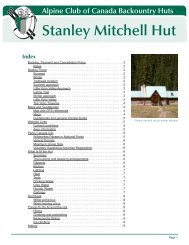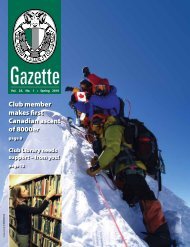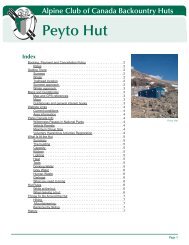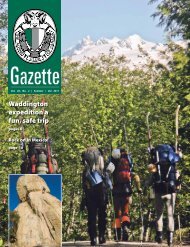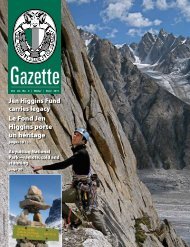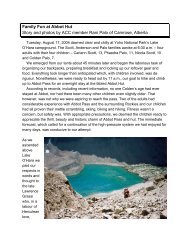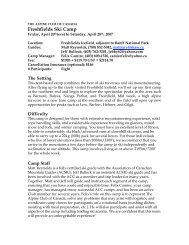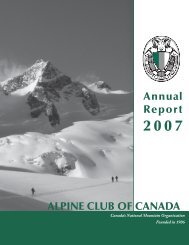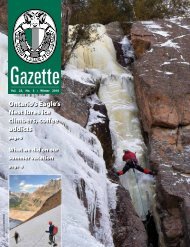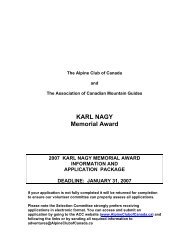Winter 2009 - The Alpine Club of Canada
Winter 2009 - The Alpine Club of Canada
Winter 2009 - The Alpine Club of Canada
- No tags were found...
Create successful ePaper yourself
Turn your PDF publications into a flip-book with our unique Google optimized e-Paper software.
Lynn soaks in the high life on the summit <strong>of</strong>Mount Tupper, Glacier National Park, B.C.Photo by Shelley Secord.Short ropeby Lynn MartelOn day three <strong>of</strong> a four-day backcountrytrip to climb one <strong>of</strong> themost obscure <strong>of</strong> the CanadianRockies’11,000ers (3353 metres), MountWillingdon, in eastern Banff NationalPark this summer, my trip companionsand I watched as a pair <strong>of</strong> tiny figuresstruggled their way tentatively down whatappeared to be a nasty, rubble-y mountainside.With a solid-looking ridge not far toone side <strong>of</strong> them, all three <strong>of</strong> us wonderedwhy they had chosen to descend a rockhardside-slope <strong>of</strong> Rockies’ crap whenmore attractive options were so nearby.<strong>The</strong>n one <strong>of</strong> my companions added,“Why would they even want to go upthat at all?”Indeed, the rounded plateau they hadascended was not actually a peak, but thehigh point <strong>of</strong> the south side <strong>of</strong> PipestonePass.Instinctively, I reeled <strong>of</strong>f several plausiblereplies, including suggestions thatmaybe they were hikers who had neverclimbed a mountain before, that theywere young and new to the mountains,or perhaps they had decided to gain thetop <strong>of</strong> the nearest high point for what I’mcertain, was a spectacular view.But later I realized there really wasonly one answer.Why not?Does a mountain have to be <strong>of</strong> acertain elevation to make it worthy <strong>of</strong>climbing? Do its slopes have to be <strong>of</strong> acertain pitch, provide moves <strong>of</strong> a certainlevel <strong>of</strong> difficulty to qualify as a climb?Does a mountain even need to have aname?Climbing, I decided is in the eye <strong>of</strong>the climber.Of course, we do apply grades toclimbs to give the person making thatfirst move a solid idea <strong>of</strong> whether or notshe might possess the skills and experienceto safely manage the climb. Butwho’s to suggest one man’s climb is lessworthy than another’s simply by measure<strong>of</strong> applied difficulty?Wasn’t it Alex Lowe who said, “<strong>The</strong>best climber is the one having the mostfun”?That’s the beauty <strong>of</strong> climbing – orscrambling, or mountaineering orbouldering or hiking up to a high point.Fortunately, there are as manydifferent motivations, as many differentstyles <strong>of</strong> climbing and climbers as thereare mountains. One man’s pile <strong>of</strong> rockis another man’s treasure chest crownedwith a layer <strong>of</strong> fossils and honeycombedquartzite piled on top <strong>of</strong> a base <strong>of</strong> SouthPacific-quality sand – as we discovered onMount Willingdon.I’m quite sure more people haveclimbed Everest than Willingdon, orMount Brown, one <strong>of</strong> the Rockies’ mosthistorically significant peaks, all 9000and some odd feet <strong>of</strong> it. That makes mehappy. While exploring the slopes andsummit <strong>of</strong> Willingdon, in one <strong>of</strong> the mostsublime, peaceful corners <strong>of</strong> the Rockies,I was warmed knowing the first – andquite non-technical ascent – was accomplishedby the surveyors who mappedthat part <strong>of</strong> the range. Not because theywere list-ticking, 11,000er peak-baggingmountaineers, but most likely simplybecause it was there. And as a bonus, theview’s good too.I hope you’ll enjoy this issue for all itsgreat views.Project seeks heritage designation to include ACC hutsby Lynn MartelFor <strong>Alpine</strong> <strong>Club</strong> <strong>of</strong> <strong>Canada</strong> members,the historic Stanley Mitchell,Wates-Gibson and Wheeler Hutsare cherished shelters amidst the wildand alluring peaks <strong>of</strong> the Selkirks andCanadian Rockies.For Albertans, however, the sturdylog cabins are treasured structures thatpreserve a valuable piece <strong>of</strong> the province’shistory. All three huts, as well asRecycle this GazettePass it onto a friend4 <strong>Alpine</strong> <strong>Club</strong> <strong>of</strong> <strong>Canada</strong> Gazette <strong>Winter</strong> <strong>2009</strong>numerous other buildings, are the legacy<strong>of</strong> Albertan Hobart A. Dowler and histeams <strong>of</strong> skilled tradesmen, who builtabout 100 log and stone cabins, lodgesand camps between the 1930s and 1960s.Earlier this year a project titledMaster Builder with Logs and Stones:<strong>The</strong> Alberta Legacy <strong>of</strong> Hobart A. Dowlerwas launched, through a submissionto the Alberta Historical ResourcesFoundation. <strong>The</strong> project aims to honourDowler’s legacy <strong>of</strong> log and stone bycelebrating the communities where helived and worked. <strong>The</strong> man spearheadingthe project, Ross W. Wein, hopes theproject, which includes efforts to gatherand present information, first-handaccounts and personal memories <strong>of</strong>Dowler’s workmen and family members,will lead to heritage designation forDowler’s unique structures, which alsoinclude the Fort Museum <strong>of</strong> the NorthWest Mounted Police in Fort Macleodand the movie prop cabin in River <strong>of</strong> NoReturn, which starred Marilyn Monroeand Robert Mitchum.Anyone interested in becominginvolved by sharing information,including oral history, contacts, reports,photographs or press clippings is invitedto contact Wein at 780-436-0141 orrosswein@shaw.ca
Follow in the footsteps<strong>of</strong> <strong>Canada</strong>’s greatest explorers!“...these books <strong>of</strong>fer deep and rich insights into thecaptivating, scenic, remote and inviting RockyMountain landscape.”—Lynn MartelLife <strong>of</strong> the Trail is a fascinating series thatguides today’s hikers and armchair travellersthrough the stories <strong>of</strong> historic routes in theCanadian Rockies. Complete with accurateroute information and stunning archivalphotographs, these books will appeal toadventurers and history buffs alike.Collect the whole series...LIFE OF THE TRAIL 1 HISTORIC HIKES INEASTERN BANFF NATIONAL PARKLIFE OF THE TRAIL 2 HISTORIC HIKES INEASTERN JASPER NATIONAL PARKLIFE OF THE TRAIL 3 THE HISTORIC ROUTEFROM OLD BOW FORT TO JASPERLIFE OF THE TRAIL 4 HISTORIC HIKES INNORTHERN YOHO NATIONAL PARKAVAILABLE AT YOUR LOCAL BOOKSTORE OR BY CALLING 1.800.665.3302THINK OUTSIDE<strong>Alpine</strong> <strong>Club</strong> <strong>of</strong> <strong>Canada</strong> Gazette <strong>Winter</strong> <strong>2009</strong> 5
Ice and the citystory and photo by André MahéIt all started on page 13 <strong>of</strong> the Patagonia Fall/<strong>Winter</strong> 1992catalogue, when I first saw an inspiring photo <strong>of</strong> an iceclimber on the “artificial cascade in Courchevel, France”.Immediately, I was convinced that if a small town in a mountainsetting could have an artificial ice climbing structure,then all the more reason for St. Boniface, Manitoba to haveits own “tour de glace” – never mind that I had never iceclimbed. After four years <strong>of</strong> cajoling, convincing, begging andhard work, a small group <strong>of</strong> friends and I finally succeeded inerecting a structure allowing us to climb on our own “artificialcascade” on the vertically-challenged Prairies. After manymore years <strong>of</strong> work, we now have a permanent structure that isunique in all <strong>of</strong> <strong>Canada</strong> – a 20-metre ice tower situated on thebanks <strong>of</strong> the Red, across the river from downtown Winnipeg.Over the years, the <strong>Club</strong> d’escalade de Saint-Boniface (St.Boniface Section <strong>of</strong> the <strong>Alpine</strong> <strong>Club</strong> <strong>of</strong> <strong>Canada</strong>) has introducedhundreds <strong>of</strong> people to the addictive sport <strong>of</strong> ice climbing.Our ice tower is the perfect venue to learn or to perfectone’s climbing skills – or to just have fun climbing challengingice in a most unlikely place!Every year since 2001, our section has organized an iceclimbing festival. It combines adrenaline producing competitions(speed and difficulty) with a challenging “alpine tournament”to produce a unique and unforgettable weekend festival.<strong>The</strong> next Festiglace de Saint-Boniface will take place February12 thru 14, 2010.For more information, visit our web site at: www.cesb.netLa glace en villetexte et photo : André MahéC’est en feuilletant le catalogue été/hiver de Patagonia en1992 que mon regard s’est vite arrêté sur la photo d’unglaciériste accroché sur le flanc d’une cascade artificiellesituée dans la station de ski française de Courchevel. Même sije n’avais jamais fait d’escalade sur glace, je fus immédiatementconvaincu que ce genre d’activité pouvait se pratiquer à Saint-Boniface. Si l’on pouvait avoir une structure artificielle de glaceen milieu alpin, pourquoi ne pourrions nous pas avoir, nous aussi,notre propre tour de glace en plein milieu de la plaine manitobaine!Après quatre années de travail par un petit groupe d’amis, nouspouvions finalement grimper de la glace verticale chez nous.Aujourd’hui, suite à la contribution et au dévouement deplusieurs, notre tour de glace de 20 mètres est située dans un parcqui longe la rivière Rouge, tout près du centre ville de Winnipeg.À travers les années, le <strong>Club</strong> d’escalade de Saint-Boniface(Section Saint-Boniface du CAC) a initié des centaines depersonnes aux plaisirs de l’escalade sur glace. Notre tour de glace,unique au <strong>Canada</strong>, est un lieu idéal pour apprendre ou pourperfectionner les techniques de base en escalade sur glace – ou toutsimplement pour avoir “du fun en grimpant d’la glace”!Chaque année, et cela depuis 2001, notre <strong>Club</strong> organise unfestival de grimpe sur glace. Ce festival est un heureux mélange devives compétitions (épreuves de vitesse et de difficulté technique) etd’un “tournoi alpin”, à la fois divertissant et exigeant. Le prochainFestiglace de Saint-Boniface aura lieu les 12, 13 et 14 février 2010.Pour plus de renseignements veuillez visiter notre site web :www.cesb.net
McColl captures overall men’s title at IFSC World Championshipsby Lynn Martel<strong>Alpine</strong> <strong>Club</strong> <strong>of</strong> <strong>Canada</strong> memberand North Vancouver residentSean McColl enjoyed a stellarseason on the International Federation<strong>of</strong> Sport Climbing (IFSC) World Cupcircuit this year, capturing OverallMen’s gold at the World ClimbingChampionships in Qinghai, China inJuly.McColl, 21, placed 5th in the LeadChampionships, 6th in a hypercompetitiveBoulder Championshipsand a fatigued 43rd in the Speed eventto log more points than any other malecompetitor.McColl was the lone Canadianamong athletes from 40 countriesparticipating in the event.As a result <strong>of</strong> a string <strong>of</strong> top-fivefinishes in events through the season,McColl stood 2nd in the Overall Men’sstandings at press time.“Well-known only within therelatively small Canadian competitionclimbing community, McColl is the latestexample <strong>of</strong> a Canadian sports hero whoreceives more adulation and recognitionin international circles than he does inhis home country,” said David Dornian,Competition Climbing <strong>Canada</strong> (CEC)chair.<strong>The</strong> CEC/CCC (the ACC’s onlynon-geographic section) named McColl’sfather as national team coach for theevent when no other team memberscould go, so McColl could at least have afamiliar face in the crowd <strong>of</strong> more than5000 who watched the athletes each dayRaphael Slawinski, Phyllis Driller (M10),Stanley Headwall, British Columbia, <strong>Canada</strong>.WIKTOR SKUPINSKI<strong>of</strong> the week-long competition.“<strong>The</strong> <strong>Alpine</strong> <strong>Club</strong> <strong>of</strong> <strong>Canada</strong> bothcongratulates and thanks this exceptionalathlete and inspirational ACC member,for taking Canadian climbing to theworld, and showing us all what is possiblewithin ourselves and our sport,” Dorniansaid.Visit www.ifsc-climbing.org for moreinfo.Nominate a volunteerNominations are now open foroutstanding <strong>Alpine</strong> <strong>Club</strong> <strong>of</strong><strong>Canada</strong> volunteers <strong>of</strong> <strong>2009</strong>.<strong>The</strong> following awards recognize andcelebrate ACC volunteers for theircontributions to the <strong>Club</strong> and itsmembers:l A.O. Wheeler Legacy Awardl Honorary Membershipl President’s Awardl Silver Rope for Leadership Awardl Distinguished Service Awardl Don Forest Service Awardl Eric Brooks Leader AwardFor details on how to nominate avolunteer and nomination forms, visitwww.alpineclub<strong>of</strong>canada.ca/awardsor call the ACC National Office at(403) 678-3200 ext. 108 to receive theinformation by mail.Deadline for nominations isDecember 31, <strong>2009</strong>.FUSION TOOLSBlackDiamondEquipment.com/icetools<strong>Alpine</strong> <strong>Club</strong> <strong>of</strong> <strong>Canada</strong> Gazette <strong>Winter</strong> <strong>2009</strong> 7
All women’s team makes “Wild Ski Yin” traverseby Selena Cordeau, photos by Lydia MarmontWhat really made this trip?Perhaps it was the excitingfeeling <strong>of</strong> anticipation inour bellies as we watched the helicopterdisappear behind the last peak in sight.Maybe the immense vistas <strong>of</strong>fered to usby more than 150 kilometres <strong>of</strong> a glacierandsnow-covered haute route in B.C.’sCoast Range. Or was it the simplicity <strong>of</strong>the lifestyle, filled with truly meaningfulmoments; the daily mantra <strong>of</strong> boilingwater, the Zen art <strong>of</strong> re-packing everymorning, the meditative skiing in silence?Or the incredible lightness <strong>of</strong> being wefelt arriving at the food cache to rejoicewith maple syrup whisky, camembert andfresh apples?In the end, what stands out the mostis the amazing and subtle complexity<strong>of</strong> human landscapes exposed by thesurroundings.Being for many days in the wildinevitably reveals unknown, subconsciousboundaries within ourselves. We choseto seek this “internal” travel, to meet andhopefully cross these boundaries. Our tripwas a novelty in that we were all females– a first for all <strong>of</strong> us.Yes, the trip every guy would loveto crash – like the helicopter pilot whopromised to drop in with pizza and beers.It was not easy to put up with threeother hard-headed and used-to-provingin-a-man’s-worldwomen. Somehow wemanaged to survive the 16-day traversethrough a high glaciated route connectingTerrace to Kemano, B.C. Even better,we managed to bond in a way none <strong>of</strong>us expected. Between one’s full moonmonthly crux and another’s almostannoying keenness, between hissy fightsand sex talks, slowly a silver thread connectedone to the other, creating a string<strong>of</strong> pearls amidst a frozen ocean.Stephanie and Erika savour being warm and dry in the lowlands below Icy Pass on day 6.In early January, <strong>2009</strong> a few e-mailsslowly gave shape to our ski trip, to befollowed by presentations at local schoolsto inspire youth about nature and gettinglost out there. One trip option grabbedour interest and matched our availabilityfrom the end <strong>of</strong> April through May. <strong>The</strong>route had only been done by two parties.Ours would be the first all-femaleventure.As we studied satellite images <strong>of</strong>the area, our idea made its way onto anapplication form for the <strong>Alpine</strong> <strong>Club</strong> <strong>of</strong><strong>Canada</strong>’s Jen Higgins Memorial Fundgrant. A congratulatory e-mail and phonecall produced four huge grins. <strong>The</strong> generousgrant allowed and encouraged us togo from dream to reality.Four months later, sitting in front <strong>of</strong>steaming curry in Terrace, we all met forthe first time, 24 hours before leaving byhelicopter to our starting point. Throughthe organized chaos <strong>of</strong> last-last minuteshopping, packing, food cache buildingand late night/early morning gearfiddling, we became acquainted. LydiaMarmont, 25, half and half Kiwi/Canuck,lives in Stewart, B.C. works as a ski guideand avalanche technician for the Ministry<strong>of</strong> Transportation. Stephanie Lemieux,31, Quebecoise pure laine, sings like agoddess, lives in Quebec’s Chic-Chocmountains and works as an avalancheforecaster. Erika Flavelle, 30, from CzechRepublic, lives in Whistler and works asa ski patroller, moonlighting as a gardendiva on Lasqueti Island. And SelenaCordeau, 25, a B.C./Quebec blend lives inGolden, B.C., and works as a river guidein the Yukon who never misses a chanceto laugh.That was on paper. Reality was:Lydia-miss-cohunes, Stephanie the yogi,Erika the wild Czech čmelák and Selena8 <strong>Alpine</strong> <strong>Club</strong> <strong>of</strong> <strong>Canada</strong> Gazette <strong>Winter</strong> <strong>2009</strong>
the eco-freak. <strong>The</strong> all-female trip allowedus to fully be, feeling free to expressourselves and our full potential.<strong>The</strong> first few days saw some clumsymistakes; spilled gas into a full backpack,the dramatic final flight <strong>of</strong> the yellowsleeping pad over a cliff, and other mishaps.Luckily warm weather, a stunninghigh pressure and solid snow conditionssmoothed the learning curve. <strong>The</strong> springmelt-freeze provided a supportive crust,creating perfect travelling and safe conditionsthroughout the trip. Those conditionsenabled us to try a variation <strong>of</strong> theoriginal route by climbing up a short coland dropping on the southeastern aspect<strong>of</strong> the Dog’s Ears – twin peaks reaching2530 metres. A bergschrund crossing andsome steep step-kicking led us throughthe col, thereby avoiding a long slog downinto the valley and back up the followingdrainage.Arriving at the first <strong>of</strong> two foodcaches we had dropped from thehelicopter, weather rolled in. <strong>The</strong> eternalmountain question arose; stay high andwait out the storm, or drop down intothe valley and keep moving? After somehumming, ha-ing, a quick weather forecastcheck on the sat phone and a c<strong>of</strong>feeand Baileys session, we chose the latter. Itwas the only time we had to escape belowtree line during the entire trip. It’s beensaid it’s not a Coast Mountain traversewithout a river crossing or two and ahealthy dose <strong>of</strong> alder bashing – problemsolved.Travelling through forested areas <strong>of</strong>the Atna River headwaters, we noticedthe absence <strong>of</strong> logging activity, realizinghow rare and precious it was to be inunscarred B.C. backcountry. <strong>The</strong> valleysheltered us for two days. Althoughcalm nights were a treat, we longed toreturn to alpine terrain. <strong>The</strong> followingmorning we headed back to the land <strong>of</strong>glaciers, cornices, steep runs, couloirs andjagged peaks, our spirits rising with thebarometer.For another week we continued,descending low enough to tag somealpine shrubs and collect and transport alarge mouse in a down bootie for a day,climbing over icy, exposed, re-namedPeak Suchalongd**k, schraulping lines ina random alpine bowl west <strong>of</strong> NaninkaLake, white-out navigation, ski-cuttingspring slop, short-cutting up couloirs andperfecting the art <strong>of</strong> block cutting andkitchen building – the perfect outlet forpent-up feminine energy.Day 16 we returned to civilization,leaving a crisp winter morning anddescending into a blazing hot corn rundown to the headwaters <strong>of</strong> HoretzkyCreek. We hiked the last nine kilometres,skis on packs, watching the spring seasonprogress with the steady elevation loss.Our secret desire for four handsomemen to greet us was quickly forgottenafter seeing four handsome grizzly bearsgrazing less than 100 metres away as wepassed the KM 0 sign at Kemano Village.(While we finished in Kemano andwould like to thank Rio Tinto and theguys in Kemano very much for theirassistance, anyone interested in completingthis traverse should know Kemano isprivate property owned by Rio Tinto. <strong>The</strong>recommended finish is by floatplane viaTatsa Lake.)Our amazing journey went far beyonda simple journey through geography,following weaknesses in topography. Inthese exposed areas, our senses unitedwith our beings. Assess, review, ponderand be, simply. Our next challenge isto keep these areas wild for others toexperience.Many thanks to the ACC’s JenHiggins Memorial Fund, and also toMEC, Backpacker’s Pantry and Rabclothing. Thanks also for the help andadvice <strong>of</strong> many people, including JohnBaldwin, Shane and Suki Spencer, ScottFlavelle, Hatha Callis, Philipe Gauthierand many other resourceful friends.Merci!Stephanie cracks a proud smile as she reachesDog’s Ear col.INTEGRALDESIGNSExpedition Down SleepingBags Made in <strong>Canada</strong> ForOver 20 YearsXPD1Rockies Series***** Rating- Rock and Ice 2008 Gear GuideOld-world craftsmanship.Wide temperature range.Choice <strong>of</strong> relaxed or broadfit and choice <strong>of</strong> PertexMicrolight or Enduranceshell. Best foot section.Good warmth/weight ratio.Space inside for waterbottles, boots, etc.Available at:Le Yeti - MontrealMountain Magic - SurreyOutdoor Approach - CalgaryRed Shreds - Williams Lake5516 - 3rd Street S.E. Calgary403-640-1445www.integraldesigns.com<strong>Alpine</strong> <strong>Club</strong> <strong>of</strong> <strong>Canada</strong> Gazette <strong>Winter</strong> <strong>2009</strong> 9
Jungle, desert and elusive spider monkeysby Meghan J. WardFinding information about the hikeup Cerro Chirripo, in Costa Rica,had been a frustrating trail <strong>of</strong> deadends. I was shocked, then, to see that mypermit was actually in order upon myarrival at the Ranger Station at the base<strong>of</strong> the mountain.“Is there a map?” I asked the parkwarden.“No,” he replied, and then began toexplain the easiest and steepest parts <strong>of</strong>the trail, and where to get water along theway, all in rapid-fire Spanish.With that, I nodded with a big smileand made my way to the hostel, whichstood at the base <strong>of</strong> the 3821-metre(12,529-foot) peak.It would be ten kilometres from thetrailhead to Crestones Base Lodge, basedon the meagre description in my guidebook,and I felt confident that the daywould be hard work, but enjoyable. <strong>The</strong>trail to the summit <strong>of</strong> Cerro Chirripo wasonly 16 kilometres, and about 2.5 verticalkilometres, which was totally manageableby the standards <strong>of</strong> my past experience,hiking and climbing in my home mountains,the Canadian Rockies. This was thefirst time, however, I had embarked ona solo hike <strong>of</strong> this length and elevationgain, let alone one in a foreign country.After my 3:45 a.m. alarm sounded, Iset <strong>of</strong>f for the trailhead. I hiked with thesunrise, and the soundtrack <strong>of</strong> the junglecame to life, at times startling me withnew and spontaneous sounds. My hopewas to spot some spider-monkeys wherethey apparently spend their time, but Ihad no luck seeing any along the way.Around the seventh kilometre, Istopped at a common rest area calledLlano Bonita (Beautiful Plain). I wastired and my pack was digging into myshoulders, perhaps due to the canned fruitand giant jar <strong>of</strong> Nutella I had foolishlypacked.As I rested, a sign caught my eye. Itsaid, “7.5 km to Crestones Base Lodge”,indicating it would be 4.5 kilometresfurther to the base lodge than I originallyplanned. My trustworthy guidebook hadbetrayed me.<strong>The</strong> news ruffled my feathers a bit,but I didn’t let it discourage me. As Icontinued up the steep trail though, myenergy began to drain. I hardly noticedthat I had entered an entirely scorchedportion <strong>of</strong> the jungle, the victim <strong>of</strong> aforest fire back in the 1990s. As a thickfog descended on the trail, I entered aneerie world <strong>of</strong> skeleton trees that <strong>of</strong>feredlittle motivation or excitement.When I reached the 13th kilometre,my feet felt like anvils and my upper backwas screaming for relief. Feeling pathetic,I laughed at myself as I visualized anotherhiker stepping over my limp body as I layon the trail, unable to move. All the same,I relished the challenge and eventuallycrested the final uphill section <strong>of</strong> the trailand descended to the lodge.I learned two things very quickly uponarriving at Crestones Base Lodge, whichsits at 3374 metres (11,063 feet): that itcan go below zero degrees in Costa Rica,and that the Central American countryhas better Internet access than anywhereelse I have been in the world. Cruisingthe Internet at this elevation was a guiltypleasure. Unfortunately, shivering my waythrough my first night was no pleasureat all.My 2:30 a.m. alarm was a welcomesound after a sleepless night, and I wastedno time hitting the trail, hoping thefive-kilometre hike to the summit wouldwarm me up. Despite low clouds, theviews from the summit were spectacular. Istood in total remoteness and solitude atthe top and loved it. For the first time inthe foreign country, I felt totally at home.Standing at the summit, I was in myelement, and it felt totally familiar despitescenery that could not have been moredifferent from the Rockies.My hike back down from the lodgethe next day was fast and enjoyable,mostly because I actually slept the nightbefore, thanks to the blanket I had rented,and my new friends at the lodge who hadtaken pity on my lack <strong>of</strong> hot food and fedme c<strong>of</strong>fee and hot macaroni.As I passed the signpost for the lastkilometre <strong>of</strong> trail, I was excited to finish,but somewhat sad I hadn’t seen anymonkeys. <strong>The</strong> winding trail through theforest looked enchanted as a light mistsettled all around.And then I heard it – at first a branchcracking and then the rustling <strong>of</strong> leaves.A pack <strong>of</strong> spider monkeys was makingits way through the forest just a fewmetres away, and though I only saw theirsilhouettes in the mist, it was a welcomesurprise, and a perfect finish to my solotrek up Cerro Chirripo.Meghan Ward is a Rocky MountainSection member and a freelance writer basedin Banff. www.meghanjoyward.com10 <strong>Alpine</strong> <strong>Club</strong> <strong>of</strong> <strong>Canada</strong> Gazette <strong>Winter</strong> <strong>2009</strong>
Safety Committee ice climbing tipsby the members <strong>of</strong> the ACC Safety Committee<strong>The</strong>re is an inherent conflict associatedwith mountaineering that allclimbers and institutions, such asthe <strong>Alpine</strong> <strong>Club</strong> <strong>of</strong> <strong>Canada</strong>, have to dealwith. All forms <strong>of</strong> mountaineering aredangerous, yet part <strong>of</strong> the enjoyment formany climbers comes from taking a calculatedrisk. Climbers need to minimizeobjective risk in their pursuits throughproper equipment, skills and leadershiptraining, and appropriate procedures. Thisconflict can never be really resolved, butimproving safety in mountaineering isone <strong>of</strong> the missions <strong>of</strong> the ACC.For many years the ACC has had aSafety Committee, which promotes safetyin mountaineering, reviews accidentsand provides advice to the Board andthe <strong>Club</strong> on safety-related issues. As<strong>of</strong> <strong>2009</strong>, the members <strong>of</strong> the SafetyCommittee are Peter Amann, a fullycertifiedACMG mountain guide livingin Jasper, Alberta, Ernst Bergmann fromEdmonton, (chair), Robert Chisnall fromToronto, Frank Pianka from Thunder Bayand Selena Swets from Victoria, B.C.<strong>The</strong>re is currently one opening on thecommittee, to be filled soon. <strong>The</strong> committeereports to the ACC’s Vice-President<strong>of</strong> Services.With ice climbing season upon us, thecommittee has compiled a few importantsafety tips.1) Be prepared. Make sure you arephysically ready for the season. If youhaven’t done any similar activity sincelast season, try conditioning yourself andtake it easy initially. Trying immediatelyto lead the same difficulty as you did lastApril, after a full winter <strong>of</strong> ice climbing, isasking for trouble.2) Check and maintain your equipment.Check your picks and crampons formarks and rust; they can break. Hopefullyyou oiled them after last use and they arestill sharp. Check your ropes for wear orRecycle this GazetteLeave it in yourphysio’s <strong>of</strong>ficedamage. How old are your slings, cordellettesand Screamers? Are your screwsstill sharp and working? Is it maybe timefor a new helmet or harness? Having gearthat makes you appear like you have iceclimbed for 30 years may look cool, but isnot necessarily safe.3) Use reliable protection and anchors.Know how to place screws and buildAbalakovs and anchors. Anchors shouldbe EARNEST (Equalizing, appropriateAngle, Redundant, Non-Extending,Strong, Timely). Be mindful that protectionand anchors in ice, primarily, dependon the quality <strong>of</strong> the ice!4) Protect your belay! Avoid fallingdirectly on your belay by placing a screwwith a Screamer immediately afterleading <strong>of</strong>f. Falling directly onto the belaywithout any additional protection canlead to disaster (and has).5) Observe the ICE – Become pr<strong>of</strong>icientat reading ice and listen to your instinctsif the ice appears detached, ablated, toocold and brittle, warm, wet and s<strong>of</strong>t, orPhoto: Doug Chabot/GNFACanything else but clear, blue and hard.6) Environment – Ice climbing presentsunique challenges in that the time framefor good and safe conditions is <strong>of</strong>ten veryshort. Because <strong>of</strong> temperature, weatherchanges and the short days in winter, thewindow <strong>of</strong> opportunity (and safety) is<strong>of</strong>ten only a few hours. Remember thatyour best defense against avalanches isterrain. Know what’s above and aroundyou, both on the climb and also on theapproach. Be aware <strong>of</strong> run-out zones andslope angles around you.Be ready for emergencies. Everybodywants to go light, but try to have enoughgear to prevent an injured person frombleeding to death or becoming hypothermic.Carry the gear to determine exactlyyour location and communicate the needfor a rescue if needed. (<strong>The</strong> new SPOTsatellite messenger is a brilliant solutionfor both.) Also, update your first aid andrescue skills.Have fun and be safe – not necessarilyin that order.27 meters straight ahead.Any questions?Now’s not the time to wish you’d read the manual.Clear distance and direction. Fast processing.No questions. No bull.Ease-<strong>of</strong>-use and proven reliability make the Tracker DTSthe most widely used avalanche beacon in North America.Tracker DTS: ease <strong>of</strong> use when it matters most.For more information on avalanche beacons and education,check out backcountryaccess.com/educationBackcountry Access, Inc.Boulder, Colorado USA800.670.8735<strong>Alpine</strong> <strong>Club</strong> <strong>of</strong> <strong>Canada</strong> Gazette <strong>Winter</strong> <strong>2009</strong> 11
<strong>The</strong> Gazette continues to recognize the contributions <strong>of</strong> some <strong>of</strong> the <strong>Alpine</strong> <strong>Club</strong> <strong>of</strong> <strong>Canada</strong>’s most dedicated volunteers. Since joining the<strong>Club</strong> in 1991, Rod Plasman has served in numerous capacities at both the section and national levels. Rod and his wife, Valerie, have beenactive members <strong>of</strong> their local Bow Valley community for nearly 20 years. Rod is currently a member <strong>of</strong> the ACC Awards Committee, and leadsnumerous trips and camps for the Rocky Mountain Section. Over the years Rod has served as Chair <strong>of</strong> the RMS, VP Services and ACC NationalSecretary. Currently, Rod is the coordinator and active leader <strong>of</strong> the Backcountry Skiers in Training (BIT) Program for the RMS. Rod receivedthe <strong>Club</strong>’s Distinguished Service Award in 2002.My time in the ACC – It’s the people who count!by Rod PlasmanMy wife Valerie and I havealways loved the CanadianRockies. When we lived inB.C.’s Lower Mainland, we would spendour vacations in the Banff/KananaskisCountry area, and each year at the end<strong>of</strong> our vacation we would wonder whatit would be like to live there. In 1991, wedecided to take the plunge and move toCanmore.We thought the best way to get toknow the community and to find othersto recreate with would be to join the<strong>Alpine</strong> <strong>Club</strong> <strong>of</strong> <strong>Canada</strong>. We were right!We started joining Rocky MountainSection trips, especially the winter trips,and became friends with a lot <strong>of</strong> theactive Section volunteers. I decided itwould be fun to become a part <strong>of</strong> theworkings <strong>of</strong> the RMS, rather than justa participant. I became a trip leader andquickly found myself on the SectionExecutive. After three years, I becameRMS Chair, and this really introducedme to a lot <strong>of</strong> people and also to all <strong>of</strong> theinner-workings <strong>of</strong> the ACC.I soon joined the PublicationsCommittee (now Mountain Culture),chaired by then VP, Bob Sandford. Bobhad a way <strong>of</strong> making the committeeworkings fun; he still uses the line that Icoined about the committee: “I went to aparty at Bob’s place and a meeting brokeout”. Shortly after joining the CommitteeI was invited to join the NationalExecutive as VP Services. I served in thiscapacity for two years and then did twoterms as Secretary. I made a lot <strong>of</strong> friendswith members <strong>of</strong> the National Executiveand one <strong>of</strong> my strongest memories wasin 2000 when the ACC and the Japanese<strong>Alpine</strong> <strong>Club</strong> collaborated on the 75thanniversary <strong>of</strong> the first ascent <strong>of</strong> MountAlberta. Being involved as the transportationcoordinator gave me the opportunityto get to know a lot <strong>of</strong> the Japaneseguests.For the winter 2000 ski season,I introduced a new program to theRMS’s winter trip schedule, called theBackcountry Skiers in Training Program(BIT). It was amazing how popularthis program quickly became. It is nowcelebrating its 10th anniversary. <strong>The</strong>program has averaged between 40 and50 participants each year – close to 500participants over the last ten years! Whathas really inspired me is seeing people gettheir first good run in the backcountryand to see them continue on to becomegood, competent backcountry skiers. Imet a lot <strong>of</strong> my closest friends throughthis program. A lot <strong>of</strong> the programparticipants have also gone on to becomekey volunteers for the Section. This hasgiven them the opportunity to enjoywhat the ACC is really about. Since theinception <strong>of</strong> this program, other sectionshave adopted similar programs. To me,that is gratifying. <strong>The</strong> more people whoenjoy backcountry skiing, after havinglearned some <strong>of</strong> the ins and outs in a safe,controlled environment, the better!<strong>The</strong>re are always challenges wheninvolved in an organization such as theACC. Even though we all wish to enjoythe alpine environment, politics andmoney do present their own unique trialsand tribulations. <strong>The</strong> hardest part, though,is the people who have been lost overthe years; Bev, Rita, Gerta, Karl, Karen,Don, Hans and Bob E. – thanks for beingand helping inspire my passion for themountains and the ACC!Volunteering for the ACC has meanta lot to me; it has given me opportunitiesto do and learn things that I never wouldhave otherwise. My public speaking skillswent from being scared to death andstammering to having fun and doing alot <strong>of</strong> it. I have managed many ski campsand this has given me experience withhelicopters – they are seriously coolmachines!<strong>Alpine</strong> <strong>Club</strong> volunteers are one bigcommunity. By volunteering you becomea part <strong>of</strong> this community. It transcendsthe ACC to include the general mountaineeringand outdoor community. I havebeen active in the mountains for morethan 30 years and, over time, the moreI realize that it is the people you meet,become friends with and even sometimeslose, that means the most. <strong>The</strong>re is alwaysanother mountain or another run to ski,but the relationships built are irreplaceable.<strong>The</strong> ACC is a way <strong>of</strong> life for me andI could not imagine life in the Bow Valleywithout it.Rod Plasman at White Russian Col at Sorcerer Lodge, B.C. on a Rocky Mountain Section ski camp.Photo by Lenore Harris.12 <strong>Alpine</strong> <strong>Club</strong> <strong>of</strong> <strong>Canada</strong> Gazette <strong>Winter</strong> <strong>2009</strong>
SMALL INVESTMENT.BIG RETURNS.IT DOESN’T TAKE LONG TO BLOW THROUGH $24…A c<strong>of</strong>fee here, a bagel there. Maybe a pint or two after work.Consider this: 24 bucks nets you six issues <strong>of</strong> award winninghumour, world class adventure and top notch gear reviews.Not to mention awesome images, amazing people and awhole lot <strong>of</strong> “Holy #@%$!” moments.Brew your own c<strong>of</strong>fee. Toast your own bagel.1-YEAR COVER PRICE$35 .70 YOUR COST$24 .00 YOU SAVE$11 .70Subscribe ONLINE at explore-mag.com
Scottish project to honour Canadian Rockies pioneerby Lynn MartelAmidst the peaks <strong>of</strong> the CanadianRockies, Norman J. Collie was agiant <strong>of</strong> a man.Collie participated in 21 first ascents<strong>of</strong> major Rockies’ peaks between 1897 and1911 including the highest peak entirelywithin the boundaries <strong>of</strong> Banff NationalPark, 3612-metre Mount Forbes; the landmarkMount Victoria, backdrop to one<strong>of</strong> the world’s most photographed sites,Lake Louise; and also Mount Gordon,nowadays among the most popular skiascents <strong>of</strong> the Wapta Icefield area.On top <strong>of</strong> that, in 1898, it was Colliewho, with Herman Woolley, made thefirst ascent <strong>of</strong> Mount Athabasca – a fulltraverse following the northeast ridge,descending by the northwest ridge andnorth glacier back to their camp. It wasfrom that 3492-metre summit, nowamong the most frequently climbedalpine peaks in the Rockies, that Collieand Woolley saw what no man hadwitnessed before – the massive expanse <strong>of</strong>the Columbia Icefield, a virtual ocean <strong>of</strong>snow stretching before them, not to mentiondozens <strong>of</strong> unclimbed peaks includingMount Columbia, at 3747 metres secondonly to the Rockies’ highest, 3954-metreMount Robson.Collie however, was not only knownfor his explorations that contributedgreatly to the mapping and development<strong>of</strong> travel corridors in the CanadianRockies – which led to his being namedamong the first <strong>of</strong> the <strong>Alpine</strong> <strong>Club</strong><strong>of</strong> <strong>Canada</strong>’s honorary members in the<strong>Club</strong>’s inaugural year, 1906. He was alsoa respected Himalayan explorer and askilled climber who made notable ascentsin his homeland <strong>of</strong> Scotland, particularlyin the popular mountaineering centre <strong>of</strong>Sligachan on the Isle <strong>of</strong> Skye.PSST!Do you wanna be a famouswriter? Ok, how about just a writer?Contact the Gazette editor atgazette@alpineclub<strong>of</strong>canada.cato have your article, story or eventpublished in the Gazette.For the past three years, the Isle <strong>of</strong>Sky-based Collie Mackenzie SculptureGroup has been working to celebratethe huge contributions <strong>of</strong> Collie andhis frequent climbing partner and guideJohn Mackenzie, the first native Scotto become a pr<strong>of</strong>essional guide. Fourlarge hydro poles were scheduled to beremoved in September to make way forthe erection <strong>of</strong> a bronze statue that willnot only honour Collie and Mackenzie,but also help promote the value andconnection <strong>of</strong> the local landscape, wildplaces and unique Gaelic culture.To help raise funds for the materialsrequired for the two figures – 400kilos at a cost <strong>of</strong> £1000 per kilo, or $1875CDN for a total cost <strong>of</strong> about $750,000CDN – the group is issuing certificates todonors stating they have donated moneyto purchase a certain weight in bronze.Certificates will be available starting at£10 for ten grams, or $18.75 CDN for tengrams.“This will be a chance for people fromaround the world to buy in to a piece <strong>of</strong>history in the making here in Scotland,”said group member Steve Tinney.As well, 16 schools on Skye areinvolved in developing projects that relateto the stories <strong>of</strong> both climbers, Tinneysaid. <strong>The</strong>y are hoping schools from theCanadian Rockies would be interested inpartnering with them.“One idea is to twin schools onSkye with schools near the peaks in theRockies that Collie climbed and named,”Tinney said. “I’m guessing places likeJasper and Banff would be close to thesepeaks.”With the peaks, which includeMounts Lefroy, Sarbach, Diadem, SnowDome, Thompson, Murchison, Edith,Freshfield, Howse and Neptuak locatedthroughout the Canadian Rockies, indeednumerous Alberta and B.C. schools doqualify.To learn more, to purchase a certificatefor an amount <strong>of</strong> bronze or to becomeinvolved, visit www.skyesculpture.comNEW T-shirt100 % brushed cottonClimbing, hiking and ski touringguidebooks for western <strong>Canada</strong>.Large selection <strong>of</strong> topographicmaps and “Mapitfirst” s<strong>of</strong>tware.ACC labelled appareland accessories.Visit our online store or phone 403 678-3200 ext. 1www.alpineclub<strong>of</strong>canada.ca/store14 <strong>Alpine</strong> <strong>Club</strong> <strong>of</strong> <strong>Canada</strong> Gazette <strong>Winter</strong> <strong>2009</strong>
ACC takes over Glacier Park hutsby Lynn MartelAfter years <strong>of</strong> backcountry hutusers in B.C.’s Glacier NationalPark assuming that the <strong>Alpine</strong><strong>Club</strong> <strong>of</strong> <strong>Canada</strong> was responsible forrunning Asulkan Hut in Rogers Pass, theACC formally took over operation <strong>of</strong> thehigh mountain cabin in August.<strong>The</strong> ACC and Parks <strong>Canada</strong> finalizeda licence <strong>of</strong> occupation agreementformally designating the ACC as beingresponsible for the operational needs <strong>of</strong>Asulkan Hut and Glacier Circle Cabinand the basic four- to six-person highalpine Sapphire Col shelter.“We’re pretty excited, particularly withthe Asulkan Hut, which complementsthe Wheeler Hut,” said ACC ExecutiveDirector Lawrence White. “And less ona user-base, but more from a historicalperspective, we’re really excited abouttaking over the operation <strong>of</strong> GlacierCircle Cabin, since it’s a recognizedhistorical building. We’re quite honouredthey would entrust us with a recognizedheritage building like Glacier Circle.”Constructed circa 1920, the logcabin Glacier Circle Cabin was built forthe use <strong>of</strong> Canadian Pacific Railway’sSwiss mountain guides to access thetowering peaks surrounding it, a longday’s travel southward from RogersPass across the massive IllecillewaetNévé. First rehabilitated in the 1970sin an effort spearheaded by industriousmountain-lover and honorary ACCmember William Putman, more recentlythe hut was rebuilt in 2006 by a team <strong>of</strong>volunteers from the Friends <strong>of</strong> MountRevelstoke and Glacier National Parks,Parks <strong>Canada</strong> and the ACC, who gavethe aging cabin a new lease on life witha new ro<strong>of</strong> and solidly supported floor,making the building worthy <strong>of</strong> its FederalHeritage Building designation.While Parks <strong>Canada</strong> will maintainownership <strong>of</strong> all three huts, the ACC isnow responsible for all operations <strong>of</strong> thebackcountry shelters, including regularservicing and improvements, as well astaking reservations – which the ACChad already been doing for Asulkan Hutfor the past decade, and which helpedengender the formal agreement.“This arrangement happened almostthrough public misconception, sincethe ACC had been taking bookings forAsulkan for years. People just assumed itwas an ACC hut,” White said. “It got tothe point where it seemed like it was thenext logical step.”White said the ACC looks forward tolooking after the operational needs <strong>of</strong> thehuts and to bringing them to the standard<strong>of</strong> comfort <strong>of</strong> the ACC’s other huts,starting with upgrading the sleeping pads,cutlery, dishes and stove at the well-usedAsulkan Hut, which sleeps 12and is particularly busy with skitourers accessing the phenomenalterrain and deep snow <strong>of</strong> RogersPass throughout the winters.“<strong>The</strong> <strong>Club</strong> is well positionedto give the attention these facilitiesrequire,” White said. “Andwe’re looking forward to workingwith the Friends <strong>of</strong> Revelstoke/Glacier Parks, since they’ve beenso integral to the restoration <strong>of</strong>Glacier Circle Cabin. We lookforward to working with themmore to promote the values <strong>of</strong>the park.”Reprinted with permission fromthe Rocky Mountain Outlook.Above: Sapphire Col Hut. photo by Roger Wallis.Below: Glacier Circle Cabin. file photo.<strong>Alpine</strong> <strong>Club</strong> <strong>of</strong> <strong>Canada</strong> Gazette <strong>Winter</strong> <strong>2009</strong> 15
Denali debutby Dean AlbrechtAfter climbing Aconcagua inFebruary, 2008, I chose my nextbig mountain adventure – MountMcKinley. It was relatively close, relativelyaffordable and relatively challenging.Just don’t refer to its <strong>of</strong>ficial namein the presence <strong>of</strong> Alaskans. For them it’sDenali; <strong>The</strong> High One.With over 4000 metres <strong>of</strong> verticalrise from base camp to the 6194-metresummit (20,320 feet), Denali’s challengesare significant. <strong>The</strong> effects <strong>of</strong> altitude,cold, wind and precipitation combineto deny the prize to half <strong>of</strong> those whoattempt it. I chose the normal route,which ascends the West Buttress, covering25 kilometres and accommodatingroughly 75 per cent <strong>of</strong> traffic on Denali.A tip from another climber led to anearly booking with a Colorado-basedoutfit, one <strong>of</strong> the few authorized to guideon the mountain. I then sourced out afew deals on equipment and the flight toAnchorage. Double boots were the mostsignificant upgrade from my Aconcaguagear list.After months <strong>of</strong> training forthe expected big loads, our team <strong>of</strong>nine clients and three guides met inAnchorage on May 31. Dave, the leadguide, was a local legend with an enviablesuccess record. <strong>The</strong> climbers included twoBrits, four Americans, a New Zealander, aDutchman and me, the lone Canadian.Camp two. photo by Dean Albrecht.<strong>The</strong> following day we drove toTalkeetna and obtained our permits atthe national park <strong>of</strong>fice before heading tothe Air Taxi. Upon landing at base campon the Kahiltna Glacier at 2134 metres, weorganized our first camp then set aboutrigging sleds for glacier travel. Realization<strong>of</strong> the combined weight <strong>of</strong> personal andgroup gear caused many to cache theirnon-essential items.<strong>The</strong> next day we travelled tenkilometres up the lower glacier to campone at 2368 metres. Dave assured usthat the initial downhill, ominouslynamed Heartbreak Hill, was a temporaryaberration.On day three we cached a load furtherup the mountain. While enjoying anotherday <strong>of</strong> pleasant weather, we were humbledby stories from others who did notexperience the best <strong>of</strong> Denali. We buriedour loads at 3100 metres and moved tocamp two (3414 metres) the followingday, travelling early to avoid the intensesun which was a hazard from above andreflected from below. I burned the underside<strong>of</strong> my nose while others had painfulsunburn to the insides <strong>of</strong> their lips!On day five we made a back-carry toretrieve the cached load. Dave called thisan active rest day. Day six was scheduledfor a load carry up Motorcycle Hill andClimbers return to a lower camp via the Kahiltna Glacier. photo by Dean Albrecht.16 <strong>Alpine</strong> <strong>Club</strong> <strong>of</strong> <strong>Canada</strong> Gazette <strong>Winter</strong> <strong>2009</strong>
Hard and s<strong>of</strong>t skills tested on TNF Summer Leadership Courseby Ian Curran and Clifton Potter, photos by Cyril ShokoplesTwice a year, <strong>The</strong> North Face(TNF) supports training campsthrough the National Office <strong>of</strong>the <strong>Alpine</strong> <strong>Club</strong> <strong>of</strong> <strong>Canada</strong> (ACC). <strong>The</strong>courses are designed to provide leadershipskills training for active ACC sectiontrip leaders, General MountaineeringCamp (GMC) amateur rope leaders andnational camp managers.<strong>The</strong> <strong>2009</strong> Summer Leadership Coursetook place during the tear-down week(Aug. 8 thru 15) <strong>of</strong> the GMC in the spectacularlybeautiful Neptune/Trident area<strong>of</strong> B.C.’s northern Selkirk Mountains.Two ACMG mountain guides – CyrilShokoples and Helen Sovdat – providedpr<strong>of</strong>essional instruction. Additionalmentorship was <strong>of</strong>fered by amateur leaderRoger Marchand and camp managerBrad Harrison.We spent three days climbing in thealpine setting surrounding the camp. Onour first day, a sunny day dawned withthe group practising short roping on acliff behind the camp. A variety <strong>of</strong> belaystances and techniques were reviewed,practised and then tested.On Tuesday, we travelled up to andthen across the Escarpment Glacieren-route to three objectives – MountNereus, Mounts Priapus and Janus, andEscarpment Peak. Rain, fog, wind andthen wet snow were soon upon us providingus with only a rope’s length visibility.<strong>The</strong> end result was that by the noon radiocall, everyone was heading towards thetoe <strong>of</strong> the glacier realizing how lucky theywere to practise their whiteout navigationskills on their very first field day.We spent our Wednesday climbingTrident Mountain (3136 metres). Ourroute employed all <strong>of</strong> our hard ands<strong>of</strong>t skills as we took turns leading thegroup hiking, scrambling along exposedridges, rappelling from a hanging belay,short-roping steep snow slopes, crossinggaping bergschrunds on airy snowbridges and some moderate climbing onverglas-covered granite. <strong>The</strong> view fromthe summit was <strong>of</strong> little else than ourfellow climbers.On Thursday, we awoke to aclearer day and headed up to oursnow and ice school on the lowerreaches <strong>of</strong> Porpoise Glacier. Aftersome refinement <strong>of</strong> our Frenchand German techniques, wepractised pitched climbing withprotection in the form <strong>of</strong> icescrews and snow anchors, thenpractised our crevasse and rockrescue techniques.On Friday, we had planned togo for Porpoise Peak, but overnightsnow and rain precluded that route,so we went for Rhea Peak (2932metres) instead. <strong>The</strong> trip involved ascramble up an old moraine, followedby threading our way throughsnow-covered crevasse fields to the col.After gaining the ridge, we travellednortherly to a snow gully, then gainedthe rock and shortropedto the summit.<strong>The</strong> greatest views onthe summit were <strong>of</strong>our flashy new <strong>The</strong> North Face jackets.On our final day, we tore downcamp and caught a very brief glimpse <strong>of</strong>what it actually takes to be aHarrison. <strong>The</strong> respect weall held for the effortsthat generations<strong>of</strong> the Harrisonfamily have putinto making theGMC a realitywas reinforced.<strong>The</strong> first threegroups wereable to fly outthat day beforethe weathercompletelyclosed in,leaving a fewpeople andmany slingloads to go outthe next day.We thank<strong>The</strong> North Facefor its generoussupport, whichmakes this camppossible. <strong>The</strong>privileged participantswill now sharetheir acquired skillswith other members asthey continue the <strong>Alpine</strong><strong>Club</strong> <strong>of</strong> <strong>Canada</strong>’s century-long tradition<strong>of</strong> members leading members through thevalleys and up the mountains <strong>of</strong> <strong>Canada</strong>.Course participants were:Will Cadell (Prince George),Bill Cardinal (Rocky Mountain),Dylan Cooper (Rocky Mountain),Ian Curran (Edmonton),Peter Lloyd (Calgary),Benham Giwi (Vancouver),Carsten Moldenhauer (Edmonton),Clifton Potter (Rocky Mountain),Lawrence White (National)and John-Paul Zakardonski(Saskatchewan).18 <strong>Alpine</strong> <strong>Club</strong> <strong>of</strong> <strong>Canada</strong> Gazette <strong>Winter</strong> <strong>2009</strong>
JLT ad - one third page.pdf 1 01/10/09 10Leo griLLMairPatron, guides Ball <strong>2009</strong>Congratulationsfrom your friends at CMH!www.cmhski.com<strong>The</strong> Karl Nagy Memorial Award was established in 2001 to assist amateur leadersand guides in the development <strong>of</strong> their leadership skills. Until his death in 2000,Karl set an outstanding example as a mentor in the mountains and was well knownfor his leadership, safety and success.This award provides an opportunity for <strong>Alpine</strong> <strong>Club</strong> <strong>of</strong> <strong>Canada</strong> (ACC) aspiringamateur leaders and Association <strong>of</strong> Canadian Mountain Guides (ACMG) candidatesto participate at the ACC General Mountaineering Camp.<strong>Alpine</strong> <strong>Club</strong> amateur leaders and ACMG candidates are given priority inalternating years; 2010 is set for an ACC amateur leader. All applicants must becurrent ACC members. Deadline for applications is January 31, 2010. For moreinformation, visit www.alpineclub<strong>of</strong>canada.ca/activities/leadershipCMYCMMYCYCMYKBecauseIt’s <strong>The</strong>reJLTÊSPORTÒWhateverÊyourÊsport,weÕllÊgetÊyouÊcovered.ÓInternationalÊRiskÊManagementÊandÊInsuranceÊBroking.ATVÊOperatorsBackcountryÊLodgesBackcountryÊSkiingBackcountryÊTouringBirdÊWatchingBoatÊToursBoatsÊ(PaddleÊ/ÊRowÊ/ÊPower)CampgroundsÊ/ÊCampingCanoeingÊ/ÊFloatÊTripsCatÊSkiingCavingClimbingÊWallsCrossÊCountryÊSkiingCulturalÊandÊEducationalÊTourismCyclingDogÊSleddingEco-AdventureEco-CulturalÊToursFishingHeliÊAdventuresHeliÊFishingHeliÊSkiingHikingHuntingÊ/ÊOutfittingIceÊClimbingIceÊSkatingKayakingLodgesÊ/ÊCabinsMountainÊBikingMountaineeringRockÊClimbingSailingSeaÊKayakingSearchÊ&ÊRescueÊTeamsÊ/ÊOrganizationsSnorkellingSnowboardingÊ/ÊSkiingSnowmobilingSnowshoeingSurvivalÊCampingTourismÊ/ÊOutdoorÊAdventureÊAssociationsWholesaleÊTourÊOperatorsWildernessÊLodgesVancouverÊ|ÊCalgaryÊ|ÊTorontoVictoriaÊ|ÊSurreyÊ|ÊEdmontonÊ|ÊMontrŽalwww.jltcanada.com<strong>Alpine</strong> <strong>Club</strong> <strong>of</strong> <strong>Canada</strong> Gazette <strong>Winter</strong> <strong>2009</strong> 19
<strong>Canada</strong> Day celebrations a high point at GMCGMC participants celebrate <strong>Canada</strong> Day on the summit <strong>of</strong> Dolphin, which they reached by a new route.From left, Roger Laurilla, John Andresen, John Wilms, Brian McCrindle, Diane Casurella, Kerry Mader,Deborah Perret. Lying in front is Hugh McLeod. Photo by Sandy Walker.by Margaret Imai-Compton<strong>Canada</strong> Day at the <strong>2009</strong> <strong>Alpine</strong><strong>Club</strong> <strong>of</strong> <strong>Canada</strong> GeneralMountaineering Camp actuallystarted on June 27, when our campmanager, Edie Shakleton, handed outCanadian flags at breakfast in Revelstoke.<strong>The</strong> convoy <strong>of</strong> vehicles headed towardsthe helicopter staging area at BigmouthCreek in the northern Selkirks was acolourful stream <strong>of</strong> fluttering red andwhite flags.Because <strong>Canada</strong> Day ( July 1) fellsmack in the middle <strong>of</strong> the week, WeekOne was destined to be a great birthdaycelebration at this year’s camp. <strong>The</strong> campwas nestled in the valley below Trident(3136 metres) and Neptune (3201 metres)while farther to the south, Escarpment(3121 metres) and Nereus (2910 metres)framed the skyline. Although the streamrunning through the camp necessitatedsome pebble-hopping between tents,Brad Harrison’s set up team had thoughtfullyinstalled two log bridges over thefast-flowing sections.On July 1, various climbing groupssummitted Dolphin (3026 metres), Rhea(2939 metres) and Porpoise (2943 metres),proudly capturing their achievementsdraped in Canadian flags. Many camperssported Canadian flags for days afterwards,thanks to the skin tattoos ChungYee Loo so deftly applied to willingvictims early in the day.And at dinner, a rousing rendition <strong>of</strong>O <strong>Canada</strong> was sung, even though many<strong>of</strong> us tripped on the lyrics because there’san old and new version <strong>of</strong> our nationalanthem. “I just sing it the way I learnedit,” said Hugh McLeod. “I don’t rememberthe part about ‘God keep our land’.”According to Hugh, when the lyrics areelusive, just keep repeating “O <strong>Canada</strong>.”<strong>The</strong> GMC’s winning formula <strong>of</strong>spectacular climbing objectives combinedwith unsurpassed home cooking, superborganization from Harrison and his crew,and expertly guided climbs and instructionmet everyone’s expectations for bothreturning and first time campers.“This is absolutely amazing andimpressive. <strong>The</strong> camp set-up is excellent,the people are fantastic and friendly andthe climbing is mind-blowing,” enthusedfirst-time camper Vi Pickering. “I can’tbelieve I haven’t done this before.”<strong>The</strong> early season start to this year’scamp meant that many routes were stilldeep in snow, so there was a substantialamount <strong>of</strong> kicking steps by our guideson virgin snow. Sylvia Forest, the mostpetite and diminutive <strong>of</strong> guides, was theacknowledged “queen <strong>of</strong> kicking steps,”as she went out every day to stomp newtracks for those on her rope.With the exception <strong>of</strong> one morningwhen we awoke to five centimetres <strong>of</strong>fresh snow, the weather was consistentlysunny and bright and allowed us to climbevery day. <strong>The</strong> campsite was thankfullyclose to popular peaks such as Trident,Porpoise, Dolphin and Rhea. <strong>The</strong> dauntingand challenging climb to Neptunewas accomplished by three parties on twodifferent days.<strong>The</strong> GMC is certainly about climbingobjectives and achievements, but itis a “camp” after all, and it’s interestingto report on what happens <strong>of</strong>f themountains.Week One was blessed with someexceptionally talented musicians, includingJames Sawler who soothed andcomforted us at the end <strong>of</strong> every dayby singing classic ballads by CanadiansGordon Lightfoot and Leonard Cohen,as well as his original compositions. BrianMcCrindle expertly adapted MichaelJackson’s song Billy Jean into a fingersnapping trip report <strong>of</strong> his Porpoiseclimb.As for the enduring GMC traditioncontinued on page 19.Participants at the GMC enjoy a heaping mountain breakfast. photo by Cyril Shokoples.20 <strong>Alpine</strong> <strong>Club</strong> <strong>of</strong> <strong>Canada</strong> Gazette <strong>Winter</strong> <strong>2009</strong>
B.C. Mountain <strong>Club</strong> publishes centennial bookby Ron DartTo help celebrate the BritishColumbia Mountaineering <strong>Club</strong>’scentennial in 2007, editor MichaelFeller and his team have produced<strong>The</strong> B.C. Mountaineer: 100 Years inMountaineering 1907-2007.<strong>The</strong> large book, replete with excellentessays and fine photographs from differentdecades, is divided into 14 sectionscovering the Coast Mountains, poetryand songs, thinking and philosophy, andperspectives on climbing and the BCMC.<strong>The</strong> large book is a well-rounded,relatively comprehensive and balancedpresentation <strong>of</strong> climbing events and themore political and reflective aspects <strong>of</strong>mountaineering. Most <strong>of</strong> the photographsin the large and weighty volumeare visual delights that will inspire andencourage one and all to take to the rockguardians <strong>of</strong> old, frigid glaciers and whitetowers. <strong>The</strong> history <strong>of</strong> BCMC and mountaineeringin B.C. is generously covered,with much deserved attention focused onMount Waddington, but the many tripsby BCMC members that have turned6166 ORC <strong>Alpine</strong> <strong>Club</strong> 1/3pg 9/9/09 1:21 PM Page 1to challenging peaks outside <strong>Canada</strong> arealso touched on. This book clearly showsthe initial century <strong>of</strong> BCMC life as agolden and energetic phase <strong>of</strong> the <strong>Club</strong>’slife. Much gratefulness should be <strong>of</strong>feredto those who put in countless hours tomake this historic document a keeper forgenerations to come.Ron Dart is a Vancouver Sectionmember.Every second counts…continued from page 18.<strong>of</strong> trip reports, we came to anticipate theend <strong>of</strong> dinner when campers stood upand summarized their adventures. Tripreports became increasingly more creativeand competitive throughout the week.<strong>The</strong> hands-down winner in this categorywas Kerry Mader, who crafted a Tridenttrip report based on Snow White and theSeven Dwarfs featuring Roger Laurillaas the handsome Prince, Sandy Walkeras the princess Snow White and sevencampers who expertly played their partsas Happy, Grumpy, Doc, Sleepy, Dopey,Bashful and Sneezy.And for those <strong>of</strong> you who have everattended sleepover summer camp, eitheras a young person or as a GMC attendee,you’ll know what I mean when I say therewere a few undeclared “camp crushes”!Margaret Imai-Compton is a TorontoSection member.Fully automatic switchover: transmit/scanDetailed situationanalysis at a glanceAccurate navigation bymeans <strong>of</strong> bearing lineand direction arrow<strong>The</strong> world leader in avalanche safety equipment.Intuitive, visual pinpointsearch: fast andpreciseManage transceiverfunctions - printactivity with NEW2.1 s<strong>of</strong>twarewww.ortovox.com <strong>Canada</strong> 403-283-8944 www.ortovox.caphoto: N. Rapaich<strong>Alpine</strong> <strong>Club</strong> <strong>of</strong> <strong>Canada</strong> Gazette <strong>Winter</strong> <strong>2009</strong> 21
National Office newsby Lawrence WhiteFall is certainly upon us. <strong>The</strong>re issnow in the hills. Days are shorteningand toques have replaced ballcaps. <strong>The</strong>re is a reluctance to let go <strong>of</strong>summer but winter is part <strong>of</strong> what itmeans to be Canadian.With the exception <strong>of</strong> the Fall Boardmeeting, the Mountain Guides Ball,and the Banff Mountain Book and FilmFestival, autumn at the National Officeprovides time to catch up from summer’sactivities. And what a busy summer itwas.<strong>The</strong> biggest news <strong>of</strong> the year <strong>of</strong> coursewas the demise <strong>of</strong> the Fay Hut. <strong>The</strong> <strong>Club</strong>has exercised its right to rebuild on site,again, per the terms <strong>of</strong> our Parks <strong>Canada</strong>License. While these discussions worktheir way through our administrationLawrence White en route to climb Mount Huber.Photo by Pat Morrow.and that <strong>of</strong> the Parks agency, the veryreal need to clean up in the aftermath <strong>of</strong>April’s fire was undertaken. Such eventsare never planned for and when theyoccur it stretches resources in all kinds <strong>of</strong>directions. So it is with great appreciationthat we in the <strong>of</strong>fice can look to a cadre<strong>of</strong> volunteers ready to step up and gettheir hands dirty – literally. <strong>The</strong>se samevolunteers were called upon to assist witha number <strong>of</strong> construction, as opposed todeconstruction, projects over the summer.Among those was a new ro<strong>of</strong> on theWheeler Hut in Rogers Pass as well asa new kitchen. Base logs on the StanleyMitchell Hut were also replaced alongwith its kitchen.It’s not just Facilities that benefitsfrom a wealth <strong>of</strong> volunteer time, commitment,and expertise. For the secondsummer in a row, I attended the GeneralMountaineering Camp, this timeas a participant on <strong>The</strong> North FaceLeadership Course. If you’ve yet to attenda GMC, put it on your “to do” list. It istruly an exceptional experience repletewith <strong>Club</strong> spirit and climbing mentorsgiving their time to teach the art <strong>of</strong>mountain craft. Of course you don’t haveto go that far to find these selfless people.<strong>The</strong>y’re in each and every section. All youneed do is look to your local trip schedule.Another pillar <strong>of</strong> the <strong>Club</strong> is in thearea <strong>of</strong> mountain culture. This summermarked the 100th anniversary <strong>of</strong> thearrival <strong>of</strong> Conrad Kain to <strong>Canada</strong>.Your <strong>Club</strong> supported the efforts <strong>of</strong>the Conrad Kain Centennial Society(www.conradkain.com) throughout theyear, culminating in a climb <strong>of</strong> MountHuber. At 3368 metres, Huber was one<strong>of</strong> the first significant peaks that Kainguided for the <strong>Alpine</strong> <strong>Club</strong> <strong>of</strong> <strong>Canada</strong>during their summer camp at LakeO’Hara in 1909. <strong>The</strong> event also broughtout the Parks <strong>Canada</strong> Mountain WITtroupe to perform its one-man show onKain’s life. Dozens <strong>of</strong> people gatheredby the shores <strong>of</strong> Lake O’Hara to watch.If you’re interested, the play is availablefor your section. <strong>The</strong> celebrations didn’tstop there – a feature article appeared inthe Canadian <strong>Alpine</strong> Journal authored byACC member Zac Robinson, pr<strong>of</strong>essor atthe University <strong>of</strong> Alberta. <strong>The</strong>re was alsoa re-release <strong>of</strong> Kain’s famous book, Where<strong>The</strong> Clouds Can Go, with a new introductionby Pat Morrow, chair <strong>of</strong> the ConradKain Centennial Society.<strong>The</strong>se activities are really a fraction<strong>of</strong> what the <strong>Club</strong> gets involved inthroughout any given year, coast to coast,and internationally. One common threadthrough it all though is a sense <strong>of</strong> <strong>Club</strong>.We’re bound together by our passion foralpine regions and our mountain heritage.Snow, toques, and the ACC; it doesn’t getmuch more Canadian than that.ACC Funds and Grants ProgramThrough the generosity <strong>of</strong> many donors, the <strong>Alpine</strong> <strong>Club</strong> <strong>of</strong> <strong>Canada</strong> hasestablished funds to support mountaineering related projects and initiatives.<strong>The</strong> deadline for submission <strong>of</strong> grant applications is January 31, 2010. Grantrecipients will be announced March 15, 2010.<strong>The</strong> Environment Fund – provides support that contributes to the protectionand preservation <strong>of</strong> alpine flora and fauna in their natural habitat. <strong>The</strong> focus <strong>of</strong> theFund is wilderness conservation.<strong>The</strong> Jen Higgins Fund – promotes creative and energetic alpine related outdoorpursuits by young women. <strong>The</strong>se projects should demonstrate initiative, creativity,energy and resourcefulness with an emphasis on self-propelled wilderness travel,and should provide value and interest to the community.Jim Colpitts Fund – encourages young climbers between the ages <strong>of</strong> 17 and 24 toparticipate in mountain related courses and programs such as wilderness first aid,avalanche training, rock/crevasse rescue and mountain leadership training.For complete info and application forms visit: www.alpineclub<strong>of</strong>canada.ca/grantsor call the ACC National Office at 403-678-3200 ext. 108.
Mike BeedellSAVEDBY YOURVOICETHE NAHANNI – PROTECTED FOREVER!Change in park sizeIn June <strong>2009</strong>, the DehCho First Nationsand Parks <strong>Canada</strong> announced a massiveexpansion <strong>of</strong> the Nahanni National ParkReserve – from under 5,000 km 2 to over30,000 km 2 – creating the third largestnational park in <strong>Canada</strong>.<strong>The</strong> Nahanni is culturally and spirituallysignificant to the DehCho. <strong>The</strong>ir commitmentto its preservation is long-held.Thousands <strong>of</strong> people across <strong>Canada</strong> alsoadded their voice to the Nahanni campaign,demonstrating a vast and unifiedsupport for wilderness conservation. <strong>The</strong>result: a spectacular portion <strong>of</strong> our Borealwilderness ecosystem is protected forever.This was the kind <strong>of</strong> success we hadin mind when the Canadian Parks andWilderness Society (CPAWS) and MountainEquipment Co-op founded thebigwild.org.Help contribute to further successes likethe Nahanni. Add your voice to the callto protect at least half <strong>of</strong> our wild landand water across <strong>Canada</strong> – add yourvoice to thebigwild.org.PREVIOUS TODAY4,765 km 2 over 30,000 km 2<strong>The</strong> Big Wild was founded byMountain Equipment Co-opand the Canadian Parks andWilderness Society (CPAWS).



